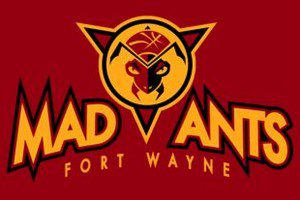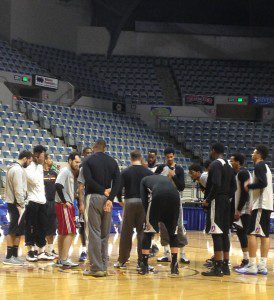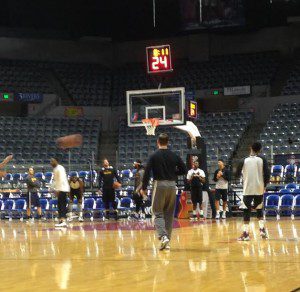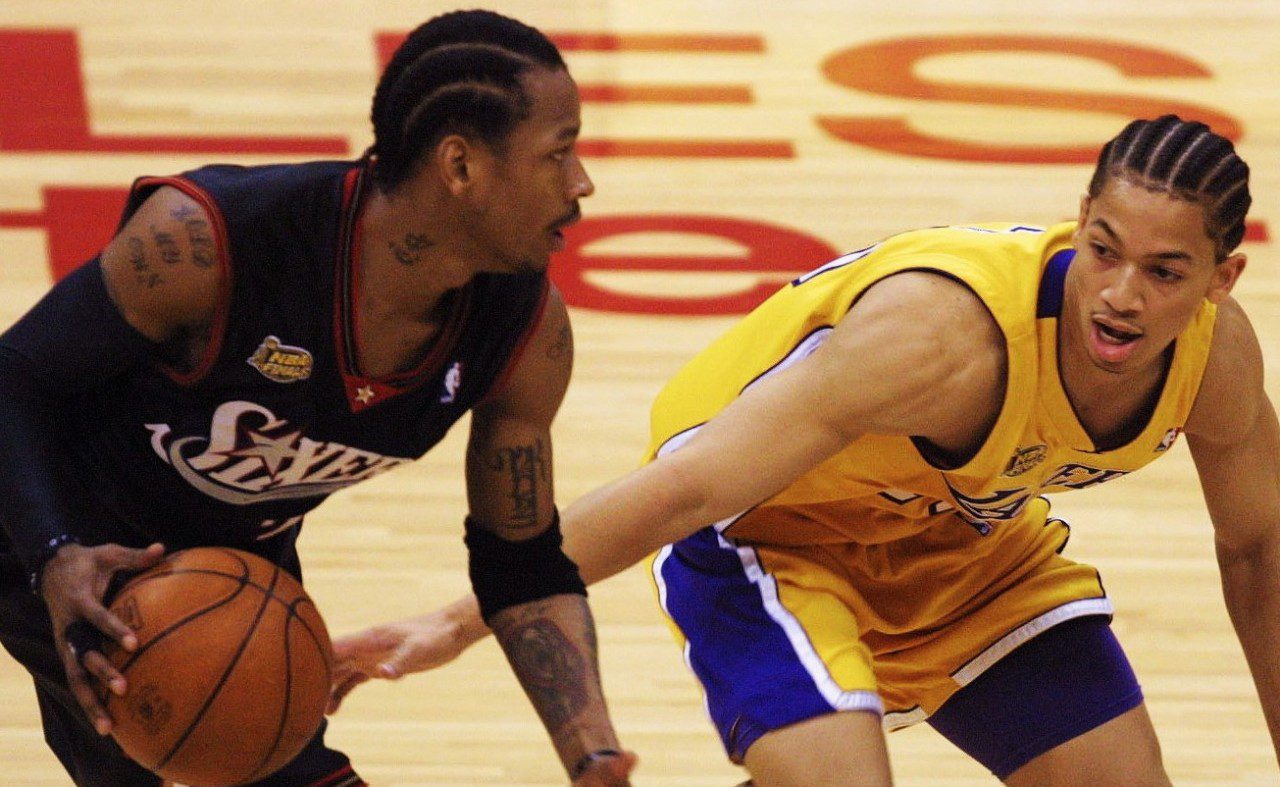Let’s be honest. We have all wanted to be on SportsCenter, to hit that game winning shot or kick the game-tying field goal. There’s just something about the big moment that makes people think “hey, I bet I could do that.” ESPN, and SportsCenter in particular, show the glamorous side of professional sports. People want to know about LeBron James, Stephen Curry, and Tom Brady. It’s fun to watch them! However, there is much much more to professional sports. In the NBA, there is more than the big paychecks and nationally televised games. It isn’t all glamour and fame.There are fringe players and small gymnasiums. From overseas to summer league, hundreds of players have seen their NBA dreams fall short. The NBA developmental league is full of those fringe playing vying for a roster spot. Teams can sign players to their D-league team in order for them to develop. Salaries are small, gyms are half-full, and the travel can be rough. However, it’s not about that. It’s about that chance to play in the NBA. From players to coaches to scouts to the front office, the dream is the big league. The D-league is the best opportunity to reach that dream. I was lucky enough to be granted a behind-the-scenes look at the the D-league with the Fort Wayne Mad Ants (Pacers affiliate). I was able to experience the day to day grind of minor league professional basketball.
My day started with a two hour drive up to Fort Wayne from Indianapolis. When I arrived at the office space, I was greeted by the general manager, Brian Levy. He directed me to the back where I met the newly hired head coach Steve Gansey. We shook hands, talked for a few minutes, before he told me that the coaches were having a meeting in two minutes. As he said that, Dylan Murphy, the assistant coach, walked in. We shook hands, both took a seat and began talking basketball. That’s the one thing I noticed hanging around these guys for a day. They just love the game. Steve said something about a left-handed shooting contest with LeBron, Dylan talked about the explosiveness of Bryce Cotton, and they both commented on the prowess of Tim Frazier, former Penn State star and last year’s D-league MVP and ROTY. All this talk in a matter of minutes. It truly was astonishing to see their love for basketball. They’re around the game all day, every day, yet they still constantly discuss other random basketball news. As the other coaches filed into the office, they nodded to me and pulled up chairs. At 10:03 AM, my first professional basketball meeting began.
I consider myself a basketball junkie. From playing to watching everything from high school to the pros, I am around the game every day. As well as watching, I read and write a fair amount as well. I thought I knew basketball. I was dead wrong. These guys know 10 times as much as I could ever hope to learn. As the meeting started, they began discussing the season outlook. Tomorrow was their season opener and they were attempting to set up a generic schedule for home and away games. It was their first season as a staff together. I learned a lot about different coaching styles and voices in the locker room. Some coaches are very strict on what they let their assistants do. Steve, on the other hand, was the opposite. He was very open to input from his assistants. They set up a schedule for warmups for the players. Some needed to work harder than others, some needed to take it easy in pre-game shooting. Steve assigned each coach to a position, and talked about the special drills he wanted players to work on. It was intriguing to see him delegate the work to some of his assistants. Some head coaches attempt to do it all. Even the great Larry Bird said the first thing he did as the Pacers coach was go out and hire two great assistants, one offense and one defense, to help him run the team. That’s why assistants are there. They aren’t there to rebound and wipe up sweat. Assistant coaches are smart, capable basketball minds who can help run a basketball team. Steve Gansey definitely used his assistant coaches. When the work is divided between them, the team has a better chance to succeed. After the warm-up discussion, they moved on to the daily game day routine. Meeting in the morning, film, another meeting, and then the game will be the norm for the coaching staff. They talked about the film schedule (who scouts each team) before switching to the practice for that day. This is when I really found out how little I know.
I watch a ton of basketball. I see things casual fans don’t see. I know who will cut and whether the elevator doors (double pick for a three) were run properly. However, these guys see things I clearly don’t. All the different names for variations of the pick and roll was new to me. In this practice, they wanted to rerun the offense, in order to work out any kinks. A lot of the practice was focused on the offensive end and making sure everyone understood the different sets for the game.
A big chunk of the meeting was spent talking about specifics for each individual players. Such as, being able to recognize when player A got tired or when player B is drifting too far out to the perimeter. A coach’s job is not just X’s and O’s, they earn their pay by making adjustments. They need to be able to recognize key themes in a game and adjust the team to make these themes work for them. Plenty of preparation goes into that. The coaching staff needs to knows who does what and when player C gets frustrated. Fort Wayne did a great job of that. They seemed very keyed in to their team and what the team mindset was. The coaching staff was very vocal. They were constantly working with players. Expect the Mad Ants to be a vocal team. The staff preached that and was always around to explain a concept for a player. The team has adopted that mindset and will explain something to another player. In the meeting, they worked on explaining things to specific players without making it seem like they were being called out. That’s key in coaching. You don’t want a player feeling called out or isolated. The staff was excellent when it came to that. They addressed issues to the whole team, rather than singling out a player in front of the team. After that, they talked about the teams for practice that afternoon.
Dylan brought up the idea to mix up the teams as starting units usually only spend 25% of their time together. Players should grow accustomed to different styles in practice and mixing up the teams helped to do that. As the meeting wrapped up, Steve reminded the rest of the coaches of their duties for that afternoon. Each coach had a specific part they were to work on with the team that afternoon.
On the way over to the stadium, Steve talked about the communication between him and the Pacers down in Indianapolis. He said that “there’s a big change of communication between Brian (scout) and Kevin Pritchard (basketball operations), Peter (basketball operations), Vance (scout), Larry [Bird]. I’m not just calling Larry and telling him what’s going on. But he always has a sense everyday of what we’re doing.” He then mentioned the possibility of one of his players being called up. He said that “the Pacers front office decides when to call somebody up. I don’t know what the situation will be with Myles Turner, but I know that Shanye and Rakeem are ready to go.” That’s a challenge for NBA D-league teams. The Pacers can call up any player at any time. Even if the Mad Ants have a big divisional matchup for playoff position, there’s a chance that their leading scorer or best rebounder will get called up before the game. We then arrived at the Allen County War Memorial Coliseum for practice.
When we arrived at the stadium, we parked in in the employee parking lot and walked through the staff/media door. A guard requested ID, Steve flashed his card, and we made our way through a series of hallways before walking out onto the court. Already, 30 minutes before practice was set to begin, there were a few players stretching and shooting. I followed Steve into the locker room and met some of the players. Some were stretching, others had headphones on, and a few were just hanging around the room. I then walked out onto court to observe the practice that day.
I picked out a courtside seat, sat down, and relaxed. I love basketball, and the prospect of missing school to watch and talk the to players was, well, beyond perfect. There really isn’t anything better. It was freezing in the arena. I noticed right away and was woefully underprepared, unlike the players, who all had sweatpants and long shirts on. I watched the players warm up before practice, noting that they hardly missed. I get comments like that all the time from people. They’re like “oh, the D-League. They must suck!” It’s truly ridiculous. D-leaguers are extremely good. They’re some of the top basketball players on the planet. It was a reminder that while sometimes it’s easy to see these guys as inferior to the regular NBA players, they are still extremely talented.
As I watched them play, I wondered what the players needed to improve on to make the jump to the NBA. Dribbling? Defensive? Three-point shot? From my perspective, they looked pretty good. Luckily, I didn’t need to wonder. I asked Terran Petteway what he needed to improve on to make it back into the NBA. He was in training camp with the Atlanta Hawks and was cut before signing with the Pacers who sent him to Fort Wayne. He put it simply, saying “ competing on both ends, showing them I can guard defensively, and be a great offensive guy”. In truth, a little bit of everything. Shayne Whittington, who has been up and down, scoring in some Pacers games before being sent to Fort Wayne the very next day, elaborated on his shortcoming. He said that “ right now, consistency. One night I’ll go out there, I went out there [preseason] and scored nine points in eight minutes against the Chicago Bulls, but only grabbed one or two rebounds. Then, in the first Detriot game, grabbed eight rebounds in 12 minutes and only scored 5 points. So, being consistent in both areas, be that way on both ends. But right now, it’s about myself and Rakeem developing. That’s what they want us to do down here, can’t do that sitting on the end of the bench. So they want us down here, playing and learning from our mistakes.”
He hit on the very point of the NBA Developmental league there in the end. Teams have minor league affiliates so their young guys can develop and play, rather than keep the bench warm every night. Those young guys learn the offense, stay in shape, and consistently play big minutes. That helps significantly when there is an injury or an open roster spot. Rakeem Christmas, Shayne, everybody in the D-League that is up and down from the big league has a huge advantage than players in years past. NBA teams are figuring out how important their developmental teams really are; that’s why the league has taken off the past few years.
As practice started, I watched the coaches closely. How well do they use the material talked about in meetings? From my perspective, the meetings helped. Practice was run smoothly and without any hesitation. The coaches knew what part they were to run, and the transition from coach to coach was seamless. It started with some basic sets for the Raptors offense and how the Mad Ants were going to defend it. After that, the team warmed up with some stretches and sprints. They switched from that to individual skill work. The guards and bigs split up and worked on their own parts of the game. On my side of the court was the guards, so I got to see most of their workout. It was mainly shooting, with some footwork and ball movement mixed in. Pass, cut, sprint around the screen, and shoot the three. Pass, fake the cut, pop back out for three. It was general drills, with emphasis on the way the Raptors defended it. Then, the Mad Ants switched into two teams and ran full-court offensive sets. Breaking a press, then working the offense on the other end. Team A and team B switched off every two, before the whole team came down to one end for defensive work. Fort Wayne worked on defensive switches, guarding the cuts, and driving from the baseline.
Finally, they ended with a twenty minute scrimmage. One team shot a free-throw, and the scrimmage was played from there. In this scrimmage, I got to see the different styles the coaches had talked about in the meeting. They mentioned to me one thing to watch for from a particular player, and sure enough, it was clear as day once I remembered them mentioning them. The coaching staff clearly had a good read of the team and its dynamic. I expect the Mad Ants to be successful this year, but the talent on the court and sidelines should make for a formidable team. After practice was over, I was able to chat with a few more players about the season and their careers before heading back to the offices.
It was a fantastic experience for me. I’ve always wanted to see the behind-the-scenes action of a minor league basketball team, and the Mad Ants were gracious enough to let me do so. It’s a great organization and I was lucky enough to be fairly close to them. Great experience, fun group of people, and overall just a good organization from top to bottom. Good luck to Steve and the Mad Ants this season.
*The Mad Ants are off to a 3-1 record to start the season.

















